Noise Control and Isolation for Multi-Family/Mixed Use Construction
Unlike concert halls, office buildings or entertainment facilities, where the time and place of sound emissions are mostly predictable and manageable, multi-family and mixed use buildings have many people doing different things in their own homes and businesses during all times of the day and night. Since neither the source of sound or noise, nor the receiver or listener can be controlled, the only means of addressing disruptive sounds is to treat the path of the sound by utilizing effective construction acoustical treatments.
Basic Concepts of Sound
Sound travels in waves. In air, sound is produced by fluctuations in air pressure. In solid building materials, sound can be produced by impact and vibration and progresses as vibration. What we hear are fluctuations in air pressure produced by the vibrating surfaces. Airborne sounds in multifamily dwellings include speech, music, noisy HVAC equipment, air and street traffic. Examples of structure-borne sounds include furniture moving on the floor, a toddler jumping about, and even an adjacent railway or parking garage.
Decibel (dB)
The decibel is commonly used in acoustics to quantify sound levels relative to a 0 dB reference, the typical threshold of perception of an average human.
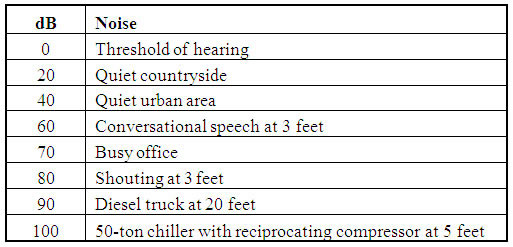
Provided by Kinetics Noise Control
Decibel levels of different sounds
In noise control, a 3 dB sound reduction is just perceptible, a 6 dB reduction is noticeable and lowering sound 10 dB halves the perceived sound.
Sound Wavelength
High frequency sounds have a shorter wavelength. A 2000 Hz sound, for example, has a 7-in. wavelength. Low frequency sounds have a longer wavelength; a 125 Hz (low frequency), for example, has a 9-ft wavelength.
Low frequency (longer) sound waves are difficult to control with standard building materials. Standard wood joist and single stud construction allows noise transfer, while hard finish floors such as tile, wood, and vinyl, on concrete or wood subfloors, readily transmit impact noise. The design of a floor/ceiling assembly, for instance, will depend on the frequencies needing to be controlled.
Architectural Acoustics
There are four major aspects of architectural acoustics:
1. Isolating sound between rooms.
2. Managing acoustics within spaces; typically by controlling reverberation.
3. Managing HVAC/Plumbing/Electrical Equipment (MEP) vibration and noise control.
4. Active audio systems such as white noise generators and noise cancelation.
This course about noise control in multifamily and mixed-use construction will concentrate on the first aspect—isolating sound between rooms and demising walls (boundaries that separate one tenant's space from that of the other, and from the common corridor).
The second aspect that focuses on acoustics within spaces is addressed by interior treatments rather than by construction methods. The third aspect of MEP vibration and sound control does contribute to noise problems in multi-family projects, as does the fourth aspect of specifying active audio systems, but they will not be fully addressed here.
Achieving Sound Isolation in Multifamily/Mixed-Use Construction
Noise control for multi-family/mixed use can be challenging as there are many sources for potential noise problems. There are obvious concerns for the neighbor’s loud television, the jumping toddler, and the barking dog. Other noise sources are less obvious—traffic noise, flyover noise, mechanical equipment noise, even noise that can breakout several stories above a gymnasium on grade when weights are dropped on the floor.
Proper planning is essential for noise control as there are many variables to consider. The materials selected for construction, head of wall details, the span of subfloor, even the gauge selected for metal studs all have an impact on quiet building construction. If noise control products are to be employed, room/hallway transitions, multiple layers of drywall for walls and ceilings, and contractor education need to be part of the planning. Addressing these and other issues during the design stage is not only critical, but yields the most economical and practical solution to noise control. In order to select the most effective noise control building system and materials, design professionals are well served by consulting an acoustical engineer. Leading manufacturers should assist by providing specifications, product performance and fire test reports of sound attenuating products on their web sites. They should also be able to offer insight on installation methods as well as product construction details in AutoCAD and PDF format.
Sound transmission class (STC) and impact insulation class (IIC) are two performance values associated with sound isolation between rooms. Both STC and IIC ratings apply to assemblies, not to individual products.
Sound Transmission Class (STC)
STC is a numerical rating of how well a building partition attenuates airborne sound. In the U.S., it is widely used to rate interior partitions, ceilings/floors, doors, windows and exterior wall configurations (see ASTM International Classification E413 and E90.) The measurement is heavily weighted in the 1000 to 4000Hz frequency. Normal speech can be clearly understood through a wall with an STC of 30. At STC 40 speech can be heard with some effort. At STC 60 loud speech is inaudible but loud music can still be heard, especially loud bass notes.
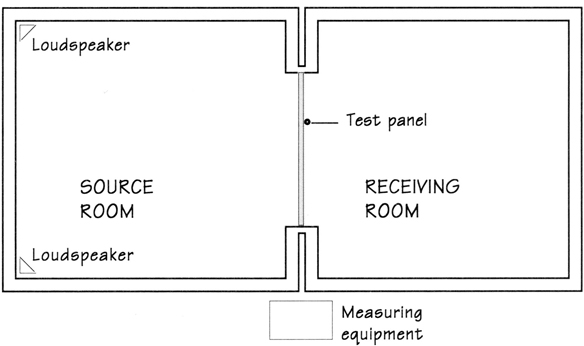
Drawing courtesy of Kinetics Noise Control
STC testing is conducted in an acoustical lab.
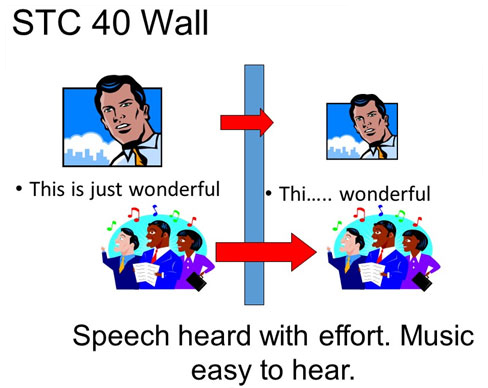
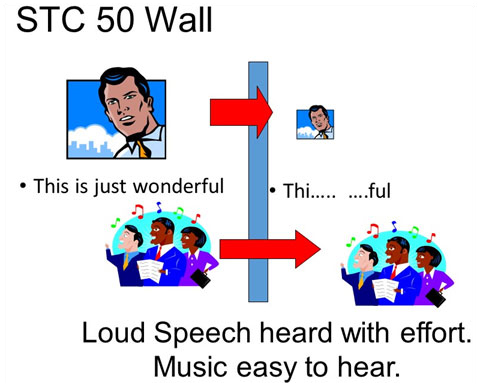
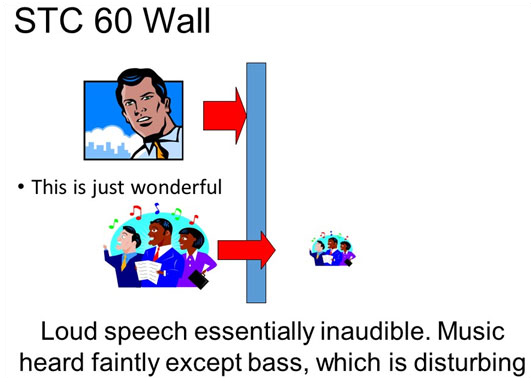
Images courtesy of Kinetics Noise Control
STC values rate how construction barriers attenuate sound.









